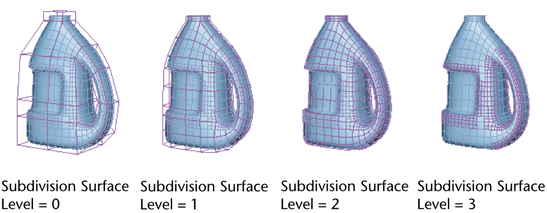Subdivision surfaces are a unique surface type available for modeling in Maya that possess characteristics of both polygon and NURBS surface types.
Like NURBS surfaces, subdivision surfaces are capable of producing smooth organic forms and can be shaped using relatively few control vertices.
Like polygon surfaces, subdivision surfaces allow you to extrude specific areas and create detail in your surfaces when it is required. This is accomplished by having the ability to work at different component levels of detail on the subdivision surface. You can switch between the different levels of detail as often as necessary.
A single subdivision surface can have different levels of detail in different regions. That is, a region that has a complex shape can have more control points to allow finer detail, while a simple or flat region will have fewer control points.

Modeling with subdivision surfaces is an easy way to create intricate objects such as human hands. It combines the best features of NURBS and polygonal modeling.
You can convert existing NURBS and polygon surface types to subdivision surfaces and vice versa.
Subdivision surfaces get their name from their characteristic “dividing into regions of greater detail”. You start with a base mesh and divide and subdivide regions into finer and finer detail, with each subdivision giving greater control in that area.
You reshape subdivision surfaces by modifying control points at the different levels of the hierarchy. The base mesh (or “level 0” mesh) allows you to reshape large areas of the overall surface. The subdivided levels allow finer control in specific regions of the surface.
Advantages of subdivision surfaces